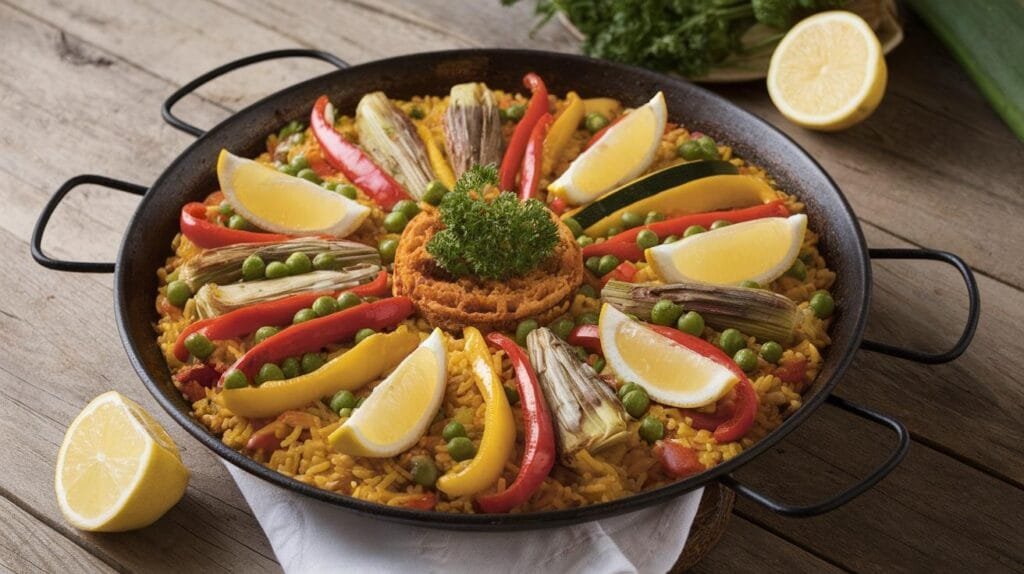Paella, the vibrant and aromatic dish from Spain, has won hearts worldwide. But what if we told you there’s a way to make it healthier and equally flavorful? Enter the vegetable paella recipe—a wholesome twist on the classic. Packed with colorful veggies, aromatic spices, and the signature crispy rice layer, this dish is an absolute crowd-pleaser. Ready to dive into the world of healthy and flavorful eating? Let’s explore every detail about this incredible dish.
Imagine a dish that’s as visually appealing as it is delicious. That’s exactly what vegetable paella offers! Originating from Valencia, Spain, paella has become a culinary icon. While the traditional versions often include seafood or meat, the vegetable variant highlights the natural goodness of plant-based ingredients.
So, why is this dish such a hit? For starters, it’s incredibly versatile. You can adapt it to fit your preferences, seasonal availability, or dietary needs. Plus, it’s a perfect example of how simple ingredients can transform into something extraordinary.
The Origins of Paella: A Cultural Perspective
Every dish has a story, and paella is no different. Paella traces its roots to the rice-growing regions of Valencia. Traditionally cooked over an open flame in a wide, shallow pan, it was a communal dish, often shared among friends and family.
Paella traces its roots to the vibrant rice-growing regions of Valencia, where it was traditionally cooked in a wide, shallow pan over an open flame. While meat and seafood paellas are often celebrated, the vegetable paella honors its heritage by highlighting seasonal produce. Pairing fresh ingredients with the classic techniques brings out the dish’s rustic charm. For a hearty twist on another traditional dish, try this Shepherd’s Pie Soup, which captures the essence of comforting flavors with a lighter approach.
Why Choose Vegetable Paella?
Vegetable paella isn’t just a feast for the senses—it’s a nutritional powerhouse. Packed with fiber, antioxidants, and vitamins from a rainbow of vegetables, it supports digestion, heart health, and overall well-being. Unlike its meat-laden counterparts, this version is lower in calories and saturated fats. Looking for protein-packed alternatives? You can complement your meal with a simple yet protein-rich recipe like these Cottage Cheese Eggs, ideal for breakfast or a light snack.
Health Benefits of Vegetable-Based Paella
Vegetable paella is not just delicious but also incredibly nutritious. Packed with fiber, vitamins, and antioxidants, it supports your overall health. Unlike its meat-heavy counterparts, this version is lower in calories and saturated fats. Plus, it’s a fantastic option for vegetarians or anyone looking to eat more plant-based meals.
Sustainability and Seasonal Ingredients
Choosing vegetables over meat or seafood reduces your carbon footprint—a small but significant step toward sustainability. Using seasonal veggies enhances the flavor and supports local farmers. From bell peppers to artichokes, the possibilities are endless.
Essential Ingredients for Vegetable Paella
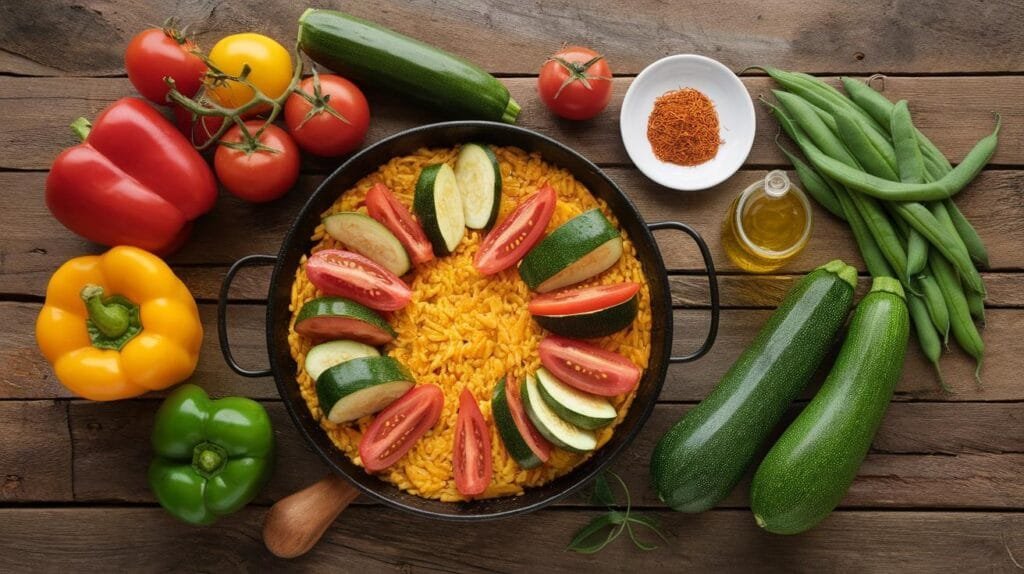
The beauty of vegetable paella lies in its versatility. Classic options like bell peppers, green beans, and artichokes not only add vibrant colors but also enhance the dish’s nutritional profile. Zucchini and tomatoes contribute creaminess and tangy depth, while peas and carrots provide a hint of sweetness. For more veggie-rich ideas, check out this Chicken Broccoli Casserole Recipe, which combines the goodness of vegetables with satisfying flavors.
What Vegetables Go Well with Paella?
Here’s where you can get creative. Popular choices include:
- Bell peppers: Their sweetness adds depth.
- Tomatoes: For that rich, tangy base.
- Zucchini: Adds a hint of creaminess.
- Green beans: A nod to traditional Valencian paella.
- Artichokes: A Mediterranean touch.
- Peas and carrots: For a pop of color and sweetness.
Don’t hesitate to mix and match based on what’s fresh and available.
Selecting the Perfect Rice for Paella
The rice is the heart of any paella. Go for short-grain varieties like Bomba or Calasparra rice. These absorb the flavors without becoming mushy. Avoid long-grain rice; it just doesn’t cut it for this dish.
Spices and the Secret Ingredient for Authentic Flavor
The magic of paella lies in its spices. Saffron, the most expensive spice in the world, is non-negotiable—it gives paella its golden hue and distinctive aroma. Add some smoked paprika for depth and a pinch of turmeric if you want to stretch your saffron supply.
Now, the secret ingredient? Homemade vegetable broth. A rich, aromatic stock can elevate your paella from good to unforgettable.
Is Paella a Healthy Dish to Eat?
The short answer: absolutely, especially when it’s vegetable-based.
Nutritional Overview of Vegetable Paella
Vegetable paella is a nutritional powerhouse. The veggies provide vitamins like A, C, and K, along with minerals such as potassium and magnesium. The rice serves as a good source of energy, while olive oil contributes heart-healthy fats.
Comparing Vegetable Paella to Traditional Variants
Unlike seafood or meat paellas, the vegetable version skips the cholesterol-heavy ingredients, making it lighter and easier to digest. It’s proof that healthy eating doesn’t have to mean compromising on flavor.
Tools and Equipment Needed
Before diving into the recipe, let’s ensure you have the right tools. Cooking paella is an art, and having the proper equipment can make all the difference.
Choosing the Right Pan for Paella
The traditional paella pan, or “paellera,” is wide, flat, and shallow. This shape allows the rice to cook evenly and helps develop the coveted socarrat—the crispy, caramelized layer at the bottom of the pan. If you don’t have a paella pan, a large, heavy-bottomed skillet works well as a substitute.
Must-Have Kitchen Tools for Preparation
Here’s a quick list of tools that will make your cooking process seamless:
- Sharp knives: For chopping vegetables efficiently.
- Cutting board: A sturdy one to handle all your prep.
- Wooden spoon or spatula: Gentle on your pan’s surface.
- Ladle: For adding broth in increments.
- Heat-resistant gloves: If you’re working with an open flame or oven.
Having these tools on hand ensures you can focus on the fun part—creating a mouthwatering dish.
Step-by-Step Vegetable Paella Recipe
Cooking a vegetable paella may sound intimidating, but breaking it down into steps makes it simple and manageable. Let’s get started!
Preparation of Ingredients
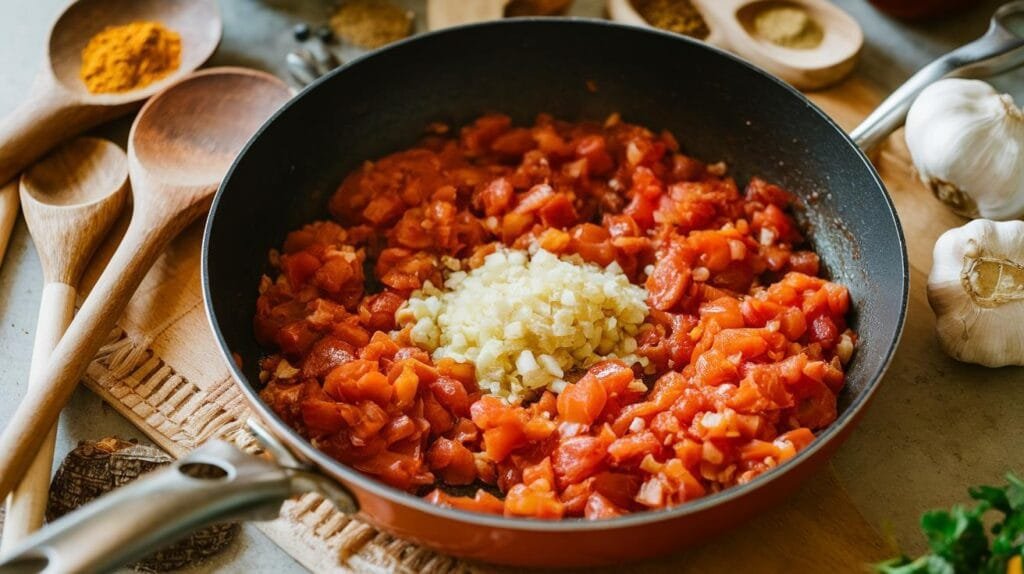
The first step is preparing your ingredients. Proper preparation is key to ensuring smooth cooking.
- Wash and chop the vegetables: Dice bell peppers, slice zucchini, and trim green beans to bite-sized pieces.
- Prepare the broth: Simmer vegetable scraps with garlic, onion, and bay leaves to make a rich broth.
- Soak saffron strands: Let them bloom in a small amount of warm water for enhanced color and aroma.
Taking the time to prep everything in advance will save you from scrambling mid-cook.
Cooking Techniques for a Perfect Paella
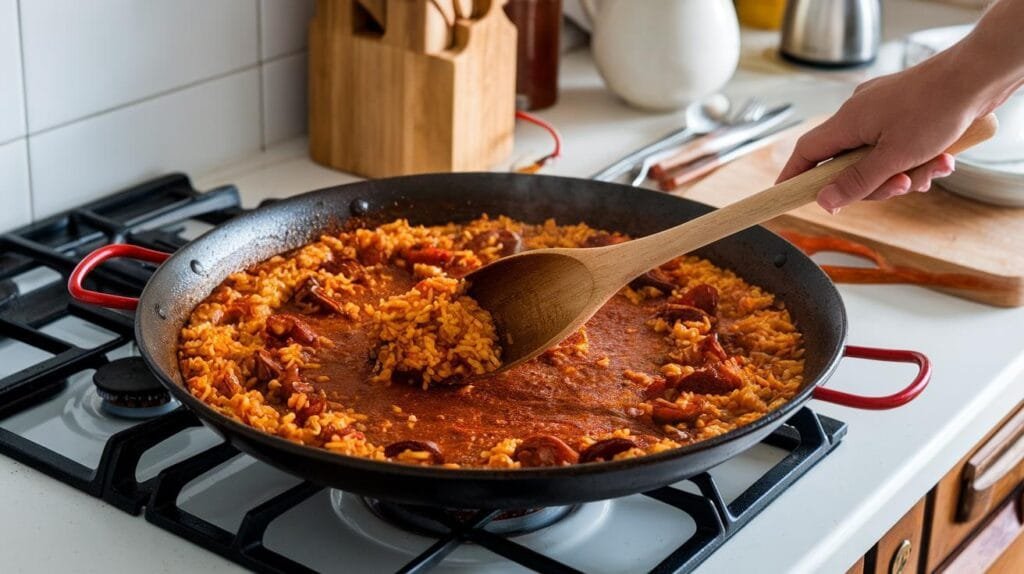
Here’s the real magic!
- Sauté the base: Heat olive oil in your paella pan. Add minced garlic, onions, and tomatoes, cooking until they form a rich sofrito (a thick, aromatic base).
- Add the vegetables: Toss in the harder veggies first, like green beans and carrots. Follow with softer vegetables like zucchini and bell peppers.
- Toast the rice: Stir in the rice and coat it with the sofrito, allowing it to absorb the flavors.
- Add the broth and saffron: Pour in your hot vegetable broth, ensuring the rice is evenly submerged. Sprinkle in the saffron-infused water. Resist the urge to stir; this helps the rice cook evenly.
- Simmer to perfection: Let the paella cook uncovered over medium heat. Adjust the heat as needed to avoid burning.
Finishing Touches and Presentation
Once the rice is tender and the broth has evaporated, increase the heat briefly to develop the socarrat. Garnish with fresh parsley, lemon wedges, or roasted red peppers for a final touch.
Transfer your masterpiece to the dining table in the paella pan itself—it’s part of the charm!
The Secret to a Good Paella
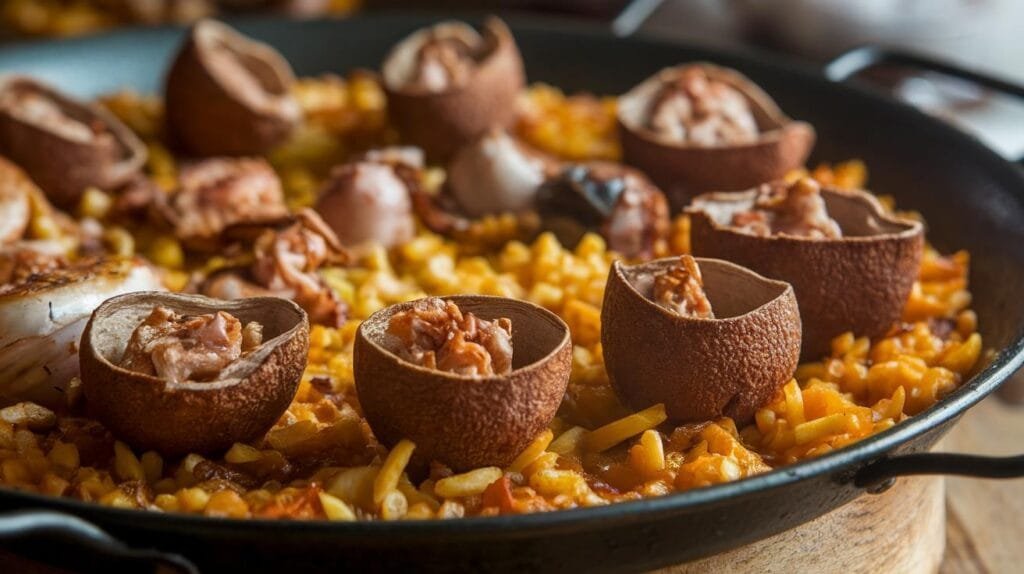
What separates a good paella from a great one? Let’s unlock the secrets that chefs swear by.
Achieving the Perfect Socarrat (Crispy Bottom)
The socarrat is the crispy, slightly charred layer of rice at the bottom of the pan, and it’s a hallmark of excellent paella. To achieve it:
- Avoid stirring during the final stages of cooking.
- Allow the paella to sit over low heat for a minute or two after the liquid is absorbed. Listen for the soft crackling sound—it’s music to your ears!
Balancing Flavors and Textures
Vegetable paella is all about harmony. Ensure your vegetables are cooked to the right consistency—some should be tender, while others retain a slight crunch. The saffron, paprika, and fresh herbs should complement each other, creating a symphony of flavors in every bite.
Common Mistakes to Avoid When Making Paella
Even experienced cooks can stumble when making paella. Here are some pitfalls to watch out for:
Overcooking or Undercooking Rice
Cooking rice is a delicate dance. Too much liquid, and you end up with mush. Too little, and the rice stays hard. Use the recommended amount of broth, and keep a close eye on the cooking process.
Using the Wrong Ingredients
Substituting short-grain rice with long-grain varieties like basmati can throw off the texture. Similarly, skipping saffron or using artificial substitutes can compromise the authentic flavor.
Avoid these common errors, and your paella will turn out flawless every time.
Serving and Pairing Suggestions
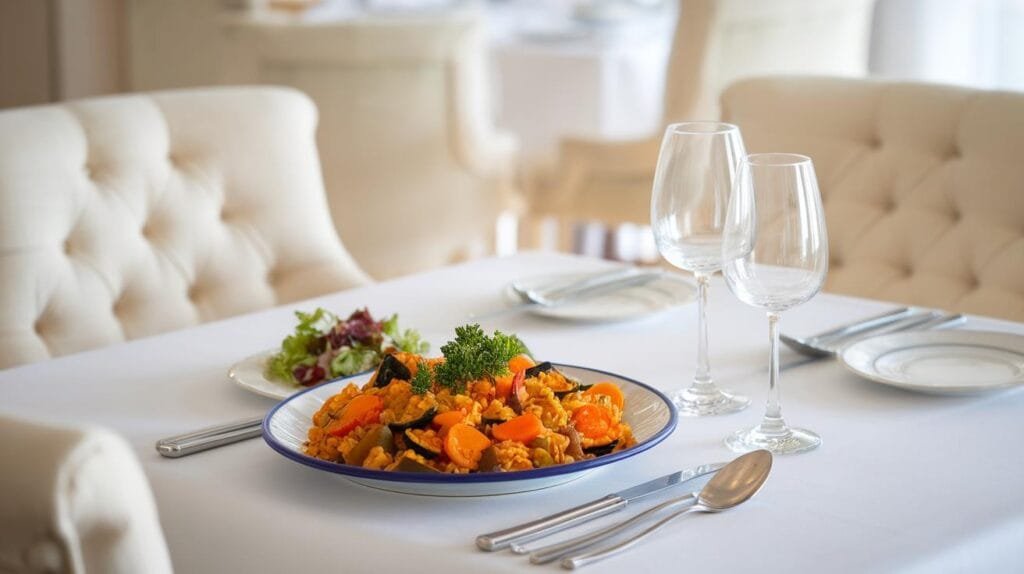
You’ve crafted the perfect vegetable paella, but how do you take it from good to unforgettable? Presentation and pairing are key.
Perfect Accompaniments for Vegetable Paella
While paella is a complete dish on its own, serving it with complementary sides can enhance the experience. Here are some ideas:
- Mixed Green Salad: A light salad with arugula, cherry tomatoes, and a zesty lemon vinaigrette provides a refreshing contrast to the rich flavors of the paella.
- Crusty Bread: Fresh, crusty bread or a baguette is perfect for soaking up the flavorful juices.
- Garlic Aioli: A small dollop of aioli adds a creamy, garlicky kick that pairs wonderfully with the crispy socarrat.
Wine and Beverage Pairings
Pairing the right drink with your vegetable paella can elevate the meal.
- White Wine: A crisp, dry white wine like Albariño or Sauvignon Blanc complements the delicate flavors.
- Sparkling Water with Citrus: For a non-alcoholic option, sparkling water with a splash of lime or orange is refreshing and palate-cleansing.
- Sangria: A fruity, chilled sangria can add a festive touch, especially for gatherings.
FAQs
What vegetables go well with paella?
Vegetables such as bell peppers, zucchini, tomatoes, green beans, artichokes, and peas are excellent additions to paella. Not only do they bring a burst of flavor, but they also enhance the dish’s vibrant appearance, making it as delightful to look at as it is to eat. Bell peppers add a sweet, slightly smoky taste, while zucchini contributes a soft, creamy texture. Tomatoes provide a tangy, rich base, and green beans offer a satisfying crunch. Artichokes lend a unique Mediterranean touch, and peas add a hint of sweetness to balance the flavors.
Moreover, using seasonal vegetables ensures the freshest taste and supports sustainable cooking practices. Seasonal produce is often at its peak in flavor and nutrients, giving your paella a wholesome edge. By mixing and matching vegetables based on availability, you can make your dish exciting and versatile. So, whether you’re a fan of hearty or tender veggies, there’s always room to customize. Plus, adding fresh herbs like parsley can elevate the flavors even more, turning your paella into a true culinary masterpiece.
What is the secret ingredient in paella?
The secret to making a great paella is all about following the right steps and paying attention to details. One of the most important parts is creating the socarrat, which is the crispy layer of rice at the bottom of the pan. To achieve this, you need to control the heat carefully and let the rice cook long enough without stirring. At the same time, using fresh, high-quality ingredients, such as seafood, vegetables, and saffron, is key to getting the best flavor.
Another important step is choosing the right type of rice. Varieties like Bomba or Calasparra are perfect because they soak up the flavors without becoming mushy. Additionally, making a flavorful broth adds even more depth to the dish.
Finally, patience is essential. By taking your time to prepare the sofrito—a mixture of garlic, onions, and tomatoes—you create a strong base for the dish. Letting the rice cook undisturbed helps build the perfect texture. When you follow these steps, your paella will turn out delicious and full of flavor.
Is paella a healthy dish to eat?
Yes, vegetable paella is a healthy and balanced meal that provides many benefits. For one, it is packed with vitamins and antioxidants from the fresh vegetables, which help support your immune system and keep your body strong. It is also high in fiber, which improves digestion and helps you feel full for longer.
Additionally, rice, the main ingredient, is a great source of energy because it is a complex carbohydrate. This means it gives you energy slowly throughout the day, helping you stay active. The dish also uses olive oil, which is known for being a heart-healthy fat. Olive oil not only adds flavor but also supports your overall health.
What makes paella even better is how customizable it is. You can add more vegetables or adjust the ingredients to fit your diet. When you use fresh, wholesome ingredients, vegetable paella becomes a meal that is not only tasty but also very good for you.
What is the secret to a good paella?
The secret ingredient that makes paella special is saffron. This bright and aromatic spice gives the dish its beautiful golden color and a unique, earthy flavor. However, saffron is not the only thing that makes paella delicious. A homemade vegetable broth is another key ingredient. It adds depth and richness to the dish, bringing all the flavors together.
To make your paella even better, it helps to layer the flavors. First, start by making a sofrito—a mixture of sautéed garlic, onions, and tomatoes—as the base. Next, toast the saffron lightly in some liquid to bring out its full aroma. Finally, using a flavorful broth instead of plain water ensures the rice soaks up as much taste as possible.
When you take your time to choose high-quality ingredients and follow these steps, your paella will turn out both flavorful and unforgettable. These small but important details make all the difference.
Conclusion: Why You Should Try This Dish Today
Vegetable paella is more than just a meal—it’s an experience. It’s a celebration of fresh ingredients, bold flavors, and culinary traditions that bring people together. Whether you’re hosting a dinner party, exploring new recipes, or simply craving something comforting yet healthy, this dish ticks all the boxes.
So, what are you waiting for? Gather your ingredients, grab your pan, and create your very own masterpiece. With every bite, you’ll taste not just the flavors of Spain but the joy of cooking something truly special.

